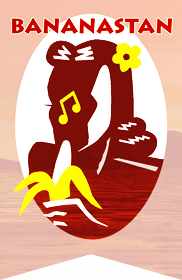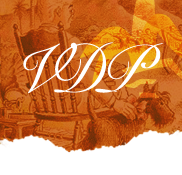
Berlin 1963-2012
Checking into the Hotel Kronprinz, on Berlin's Kronprinzendamm, the lobby seems the perfect place for a series of interviews that will follow in the next few days.
Room 368 is hidden from the street by a summer foliage of surrounding linden, buche, and kastanie (chestnut) trees. A shrink-wrapped doughnut on the desk, left by the staff as a hotel favor — just another distinguishing signature of this place. The hotel's unique charm, in a word — "Alleinstellungsmerkmal".
"Ich bin ein Berliner" is printed on a greeting card next to that pastry, explaining its name — inspired by the quotation from JFK in his speech in Berlin on June 26, 1963.
My older brother Ben was still alive that day in '63. At age 23, the youngest member in the history of the USA's Foreign Service and/or State Department.
A cool, swift breeze blows through my room's 19th century windows at the Kronprinz Hotel. Bold raindrops shatter a dappled glare. Lace curtains dance. I drift in orbit around Ben. He most likely would have been at his desk this very hour, as Vice Consul to Frankfurt. Fifty years ago.
This, during the hottest period of the Cold War, three years after Nikita Krushchev banged his shoe on a desk at the UN In a mare's nest of espionage, friction between the tectonic plates of Capitalism and Communism brought the earth as close as it could come to an atomic Armageddon.
***************Diplomacy must take grit. Ben had it, in great measure. He was here in Germany while elementary school children all over the USA were learning to dive under their desks, in practice drills. A seemingly inevitable atomic bomb drop was suspended over the nation's darkened psyche.
That ideological dispute came to a tipping point on October 25th, '62, when Adlai Stevenson, at a UN assembly, revealed U2 spy plane pictures of Soviet missile sites in Cuba.
***************I was singing Mexican boleros with my oldest brother Carson that very evening, at The Insomniac coffee house, in Hermosa Beach, California. Couched in the death knell of the Beat Era, amid escapist seductions of Andrew de la Bastide's steel band, Bessie Griffin's Gospel Pearls (accompanied by the great Eddie Kendricks), or the blues of Long Gone Miles, with Willie Chambers at his side. We drank 100 proof grain neutral White Lightening with the girls from the Gospel Pearls between sets. Vapors of cannabis snaked across the strand.
Silent movies with Buster Keaton or Keystone Kops played out on an opaque screen before each set. At show time, the projector went dead, and with a yank of a chain from stage left, the screen pivoted up, flush to the ceiling. Musical hell would break loose. Carson and I followed them all, in rapid rotation, from '62-'63, on that stage in Bob Hare's Coffee house. Our world-beat acoustics played under the shriek of the espresso and cappuccino heavy machinery. That's where we met Frank Holmes. His artful cartoon consciousness would illustrate my musical life in a powerful way. Frank led the beverage brigade, to support his art academics.
The clack of a Smith Corona, driven by the digital pistons of a local poet, banged out a staccato ostinato as a musical leitmotif. With a final flourish and the slam of a carriage return, a caricatured encapsulated personal profile was served up to the seated patrons willing to shell out a buck for the five minutes it took to have the paper fly finished, and off the spool. All liquidly fluent. Freudische!
Masculine women mixed easily with feminine men. It was first-reel Fellini. One night, Rod McKuen would read his own redacted 'Jonathan Livingston Seagull', or deliver his translation of Jaques Brel (adding an iambic dimension to this olio of "disposable art"), in hot pursuit of Warhol's Campbell Soup Can in polymer paint. One night, a not-yet 21 year old John Hammond, swathed in black leather and the dust of a cross-country ride in his hair, parked his Harley hawg in the alley and ambled in the back door, looking for a space to sing the blues. He was the road warrior I could only read about. Totally Route 66.
On the walls of the adjoining art gallery, oil paintings of doe-eyed children by Margaret Keane (who signed her husband's name to her own works) dominated the space. They sold like hotcakes, each worth thousands by now. Then, they drew in art collectors delivering a quarter million in revenues to The Insomniac that year. Keane ended up on portrait commissions for luminaries such as Joan Crawford, and Tim Burton is developing Keane's bio-pic. All this, confirming that the past isn't even past.
***************"The Endless Summer". Its soundtrack included debut artist albums The Freewheeling Bob Dylan, and the Stones' 12 x 5. These guys felt hungry and uncertain, as I did.
In marked contrast, The Beach Boys made waves that same July with 'Surfer Girl'. Their music under-scored a sated, dated contentment, somehow emerging, yet très passé. Bottling the beached bourgoisie. Ahh, that good life Horace Greeley promised lay Out West! Decidedly retro-Republican and confirming: they'd arrived, without question.
In 1963 a surfer cult arose just as the Beat era exhaled its final inhalations. That cult was made possible by the invention of epoxy surfboards that year. They were lighter than their heavy wooden predecessors (long hard-wood boards that took the shoulders of Hawaiian kings, just to plow out past the rolling surf).
Back alley garages buzzed with saws and sanders as the toxic residue flew off the polyester board blanks. That surfboard biz was truly "cottage industry" (not unlike most music production today). It brought a subcultural sea-change in language, clothing, and attitude, through the media.
Two surf board builders of the year were Mike and Jack Haley, of Seal Beach. Both West Coast surfing champions. I met their sister Tonya, who made milk shakes at the lunch counter of the Seal Beach Drug store. It was a short walk from where Carson and I rented a small house within sound of the surf. I surrendered my virginity to that beautiful blonde, without a fight.
***************I could immediately relate to the hunger in Dylan's music and lyrics. His first album got to the turntable in Seal Beach. That town, a sleep-walking freeze-frame in a sort of Eisenhower era narcosis, had 6,200 souls when I arrived in '62. It lay adjacent to a magnificent estuary, and a Navy base that seemed to have passed its purpose. My oldest brother and I found gainful employment as a folk duo at The Rouge et Noire. It was owned and operated by recent Greek immigrants George and Teddy Nikas. We earned $15 a night, for two sets. Still, with the nut of a $75 monthly rental, the margin for error was razor thin. We took on new territory, playing 'The Prison of Socrates' on the Balboa Peninsula, when the Nikas brothers opened that space. There, post-adolescent girls in fishnet stockings and berets would dangle cigarettes from their painted lips and discuss Marx or the Industrial Revolution. Gravitas mixed with Blues and Blue Grass.
Within a faint earshot, we heard amplified guitars in an audio olio of pubescent shrieks, to strains of the hodad as the Beach Boys polished their image.
We got to mix with the Newport brahmans, at bar-b-ques at the Wrigley's home on that peninsular Pacific rim. Playing music was a perfect social emollient, yet I well suspected it also held an unbeatably potent political potential, blowin' in the wind.
We burned the candle at both ends, "couché tard et levé matin!" We'd hit the hay late, after gleaning all we could from the college students we'd befriended from Long Beach State College, many of them with a concentrate in Anthropology or the Arts. Yet, we were often up at dawn's first glimmer, to scavenge past-point vegetables and fruit tossed into crates in the alley behind the market.
It was hard-scrabble stuff. Tales of Patrician pleasures and Palace Cars to Chautauqua, but a distant memory of our grandparents' families, and our own evaporated childhoods. I could relate to Woody Guthrie (although Steinbeck said the same things in fewer words). I'd read Steinbeck, but sang Guthrie. We lived the irony of this dalliance with poverty. Yet in singing 'This Land is Your Land', we knew damn well that it was not. It was "their" land, and we were suddenly outside, looking in.
***************Up the coast from Seal Beach, past the sailors' tattoo parlors on the Long Beach pike, and directly across the street from The Insomniac in Hermosa Beach, sat Howard Rumsey's Lighthouse jazz cafe.
Carson and I would go over there between our sets to catch the likes of Laurindo Almeida, Anita O'Day, Etta James, Stan Getz, Ahmad Jamal, Cannonball Adderley and an unforgettable Astrid Gilberto. (I caught her first set, just after her arrival in the US Astonished by the first insouciant notes of the bossa nova's hypnotics in 'The Girl from Ipanema'. That indelible night in the tropics! Packaged in the hushed bossa, that nova physicality was a genre that led me to many conjoined pan-American musical forms. After her maiden set, the lithe Astrid darted back to the kitchen. It doubled as a dressing room, with a white sheet slung across the back corner. Naturally, I followed her, past the crowded bar (I was under legal drinking age), and found her sobbing behind the curtain, shaken by the showbiz. I suddenly realized that I was way over my head. An implacable Venus, just across a linguistic divide, and in fact, a much older woman (three big years separated us). She obviously needed a more soigné sophisticate to talk her down. I withdrew, after a feint.
Maybe things were as hetero at jazz great Shelly Mann's "Mann Hole" (which soubriquet had an entirely different spin in those days). Nights were gay, in a word.
***************Yet, everybody who was anybody in the Jazz world played The Lighthouse Cafe. In reflecting such glory, I was getting an lesson that Carnegie Tech, in its conservatorial splendor, just couldn't have provided me. Going West, leaving the leaden academics of musical angst, and now truly un-Caged, I'd found my laughin' place.
***************"Beatnik" was a term coined by political conservatives of the '50s and '60s, to describe that pointedly unconventional counter-culture. With that suffix "nik" thrown in, they neatly painted the Beat Generation pink ("Beat" — read Kerouac), insinuating such anti-materialism was a sign of political disloyalty. ("Nik" — read "Nikita").
That dismissive reposte tarred a sub-set which at its very core was out to question precepts of McCarthyism, with its branding of anti-intellectualism. What a howl. ("Howl" — read Ginsberg). We studied the Beat era in its death throes, through genre-hopping music, art, poetry, and dance that coursed through the bloodlines of California's coastal coffee house circuitry.
The band played on.
***************A Son of the American Revolution, I never doubted my place on the Pacific rim, nor our manifest destiny to question — while Ben was covering Uncle Sam's back abroad. His, I figured as a surreptitious role, in what yet appears to be the most transparent form of government yet devised. To me, Ben and I were in flight formation, both protecting the American dream by various vicarious means.
***************In 1963, when Kennedy hit Berlin, his words vaulted its walls, erected to divide that city, in 1961.
That wall is gone now. So too, a shrinking populace that can remember how it was chiseled down at its foundation first by Kennedy's exhortations ,so long before Ronald Reagan's mawkishly theatrical call to Gorbachev to "Tear down that wall!" Now if that ain't a contrast between bravura and bravado, I don't know what...!
***************In my second night here at The Kronprinz Hotel, that "Berliner" pastry still sits, shrink-wrapped on the desk. My thoughts of '63 are as well, tightly packaged. I unwrap thoughts of "foreign service" cautiously, as I lament Ben-who-will-be-forever-young.
***************I'm brought here by Haus der Kulturen der Welt. That great Arts Institute (with a staff numbering in the forties) occupies an amazing edifice in die Tiergarten Park. Due to its spatulated form, it's known as "The Pregnant Oyster" (Schwangere Auster). Its architect, Hugh Stubbins Jr., erected it in '57. At nine tons, Henry Moore's heaviest bronze (Large Divided Oval: Butterfly) stands in the front yard, in a circular basin. I spend the last five days at that place, for its annual advisory board meetings. I advise them...only of my oblivion. They view that as immaterial, it would seem.
Within those walls, efforts to reconcile problems of multi-culturalism are ongoing, mindful of the problems of Germany's xenophobic past.
JFK stood at that very site in '63, und dabei, spoke for reunification and democracy. He, the clarion through the dimmer din of totalitarianism.
***************Kennedy: "Two thousand years ago, the proudest boast was 'Civis Romanus sum' ('I am a Roman citizen'). Today, in the world of freedom, the proudest boast is 'Ich bin ein Berliner!' All free men, wherever they may live, are citizens of Berlin, and therefore, as a free man, I take pride in the words 'Ich bin ein Berliner!'"
***************A hero is more than a sandwich.
I am beyond words.
Check out Time.
Naturally, Kennedy meant to say, "Ich bin Berliner!" Zu schade!
He really didn't mean to say he was a doughnut. (That wasn't lost on his German audience, undeflected by his malapropism, so focused on his exhortation.) Total school of charm, JFK.



